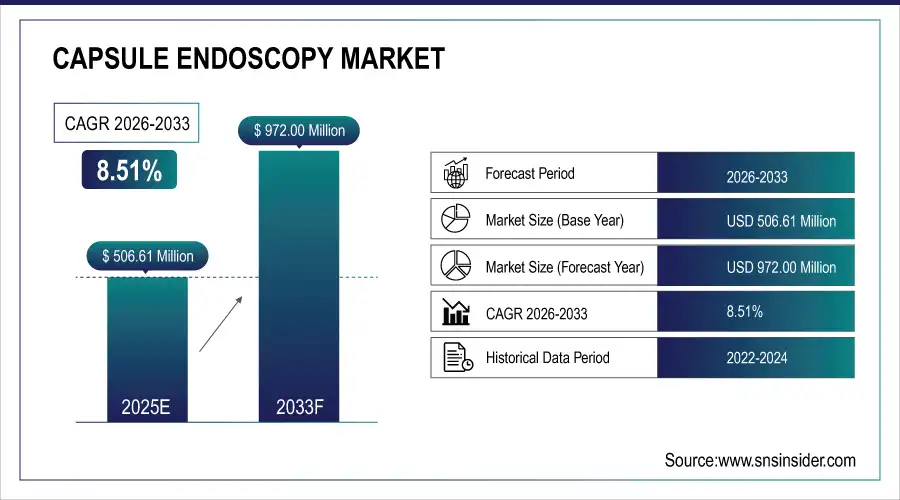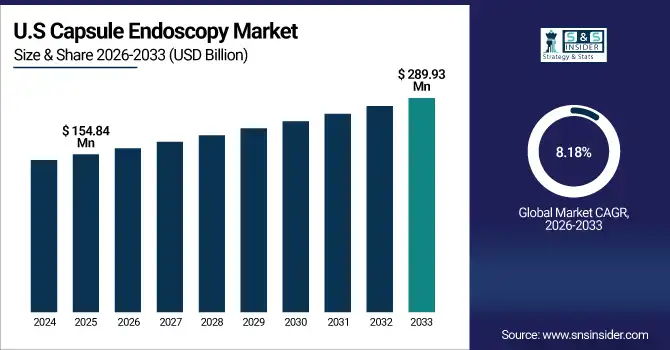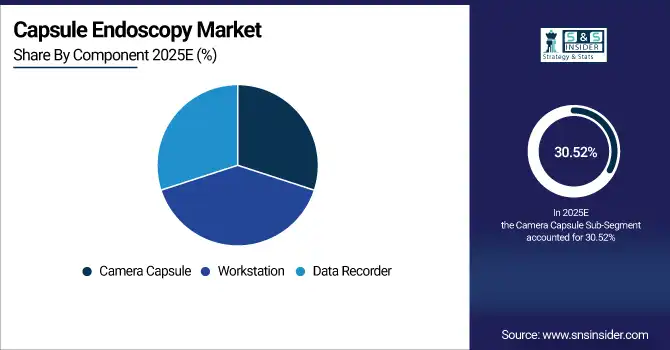Capsule Endoscopy Market Report Scope & Overview:
The Capsule Endoscopy Market size was valued at USD 506.61 Million in 2025E and is projected to reach USD 972.00 Million by 2033, growing at a CAGR of 8.51% during 2026-2033.
The Capsule Endoscopy Market analysis highlights the rapid adoption of minimally invasive diagnostic technologies to improve gastrointestinal disease detection. Small bowel capsules dominate, while colon and esophageal capsules are gaining popularity. Advancements in wireless imaging, high-resolution cameras, and data recording enhance procedure accuracy.
In 2025, small bowel capsule endoscopy accounted for over 70% of global procedures, remaining the gold standard for diagnosing obscure GI bleeding, Crohn’s disease, and small intestinal tumors.
Market Size and Forecast:
-
Market Size in 2025E: USD 506.61 Million
-
Market Size by 2033: USD 972.00 Million
-
CAGR: 8.51% from 2026 to 2033
-
Base Year: 2025
-
Forecast Period: 2026–2033
-
Historical Data: 2022–2024

To Get more information On Capsule Endoscopy Market - Request Free Sample Report
Capsule Endoscopy Market Trends
-
Rising adoption of capsule endoscopy for non-invasive gastrointestinal diagnostics, reducing patient discomfort and improving early disease detection rates globally.
-
Technological advancements in wireless capsules, high-resolution imaging, and data recording systems enhancing procedure accuracy and diagnostic capabilities.
-
Increasing preference for small bowel capsules, while colon and esophageal capsules show rapid adoption in advanced healthcare facilities.
-
Growing investment in hospital infrastructure and ambulatory surgery centers to support capsule endoscopy procedures and workflow integration.
-
Expansion of emerging markets due to rising awareness, affordable devices, and healthcare initiatives promoting minimally invasive gastrointestinal diagnostics.
The U.S. Capsule Endoscopy Market size was valued at USD 154.84 Million in 2025E and is projected to reach USD 289.93 Million by 2033, growing at a CAGR of 8.18% during 2026-2033. Capsule Endoscopy Market growth is driven by mature and rapidly evolving segment, driven by advanced healthcare infrastructure and high adoption of minimally invasive diagnostic technologies. Small bowel capsules dominate, while colon and esophageal capsules are increasingly used. Hospitals lead as primary end-users, with ambulatory surgery centers growing steadily.

Capsule Endoscopy Market Growth Drivers:
-
Increasing Adoption of Minimally Invasive Gastrointestinal Diagnostic Technologies in Hospitals and Ambulatory Centers
The growing prevalence of gastrointestinal disorders, including Crohn’s disease, GI bleeding, and tumors, is driving adoption of capsule endoscopy. Minimally invasive procedures offer higher patient comfort, reduced complications, and faster recovery compared to traditional endoscopy. Technological advancements in wireless capsules, high-resolution imaging, and efficient data recording improve diagnostic accuracy. Hospitals and diagnostic centers are increasingly investing in these systems to enhance service offerings. Rising awareness among physicians and patients about non-invasive diagnostic options further fuels market growth globally.
In 2025, over 75 million people globally were diagnosed with chronic gastrointestinal conditions like Crohn’s disease, ulcerative colitis, or obscure GI bleeding—significantly increasing demand for non-invasive diagnostic tools like capsule endoscopy.
Capsule Endoscopy Market Restraints:
-
High Device Costs, Limited Reimbursement, and Technical Limitations Affecting Market Growth
The capsule endoscopy market faces challenges due to high device costs and procedure expenses, limiting accessibility in price-sensitive regions. Limited insurance coverage and reimbursement policies constrain adoption in several countries. Technical limitations, such as capsule retention, incomplete visualization, and battery life, may reduce procedural efficiency. Additionally, the need for skilled personnel to interpret data and integration challenges with hospital IT systems restrain widespread adoption. Strict regulatory requirements and competition from alternative diagnostic methods like traditional endoscopy further impede market expansion.
Capsule Endoscopy Market Opportunities:
-
Expansion into Emerging Markets and Advancements in Capsule Endoscopy Technology
Emerging markets in Asia-Pacific, Latin America, and the Middle East present substantial growth opportunities due to rising gastrointestinal disease prevalence and increasing healthcare awareness. Technological innovations such as AI-assisted image analysis, longer battery life, and multi-functional capsules enable more accurate and faster diagnosis. Strategic collaborations, local manufacturing, and cost-effective solutions can improve market penetration. Expanding healthcare infrastructure and rising procedure volumes in ambulatory centers and hospitals provide additional avenues for growth, allowing global capsule endoscopy manufacturers to capitalize on untapped potential.
In 2025, gastrointestinal disorders surged in Asia-Pacific, Latin America, and the Middle East, with Crohn’s and colorectal cancer incidence rising by 20–30%, creating urgent demand for accessible diagnostic tools like capsule endoscopy.
Capsule Endoscopy Market Segment Analysis
-
By product, Small Bowel Capsule led the market with a 45.69% share in 2025, while Colon Capsule was the fastest-growing segment, registering a CAGR of 10.50%.
-
By application, Gastrointestinal Bleeding dominated the market with 58.10% share in 2025, whereas Tumours represented the fastest-growing segment, growing at a CAGR of 9.30%.
-
By type, Wireless Capsule Endoscopy led the market with 80.30% share in 2025, while Receiver Capsule Endoscopy was the fastest-growing segment with a CAGR of 13.18%.
-
By end-user industry, Hospitals held 65.28% of the market in 2025, while Ambulatory Surgery Centres were the fastest-growing segment, recording a CAGR of 9.45%.
-
By component, Camera Capsule accounted for 30.52% of the market in 2025, while Workstations were the fastest-growing segment, growing at a CAGR of 11.57%.
By Product, Small Bowel Capsule Leads Market While Colon Capsule Registers Fastest Growth
Small bowel capsules dominate the capsule endoscopy market due to their established use in diagnosing Crohn’s disease, obscure gastrointestinal bleeding, and other small intestine disorders. Their widespread adoption in hospitals and diagnostic centers maintains a significant market share. Meanwhile, colon capsules are registering the fastest growth, driven by increasing demand for non-invasive colorectal diagnostics and rising awareness of colon cancer screening. Technological advancements and improved imaging capabilities further support the adoption of colon capsule procedures globally.
By Application, Gastrointestinal Bleeding Dominate While Tumours Shows Rapid Growth
Gastrointestinal Bleeding segment dominates the market due to its high prevalence and the need for accurate, minimally invasive detection and primarily used for diagnosing gastrointestinal bleeding. Tumor detection, including small bowel and colon tumors, is experiencing rapid growth as early cancer diagnosis gains focus. Innovations in high-resolution imaging, AI-assisted detection, and improved capsule navigation enhance tumor identification rates, supporting faster adoption across hospitals and diagnostic centers worldwide.
By Type, Wireless Capsule Endoscopy Lead While Receiver Capsule Endoscopy Registers Fastest Growth
Wireless capsule endoscopy is the dominate type segment, favored for its convenience, mobility, and high patient compliance. It allows continuous imaging without tethering to external devices, making procedures easier in hospitals and ambulatory centers. Receiver capsule endoscopy is the fastest-growing segment, benefiting from innovations in data transmission, portability, and integration with advanced imaging workstations. Hospitals and specialized clinics increasingly adopt receiver-based systems for improved diagnostic accuracy and real-time monitoring, fueling market expansion globally.
By End-User Industry, Hospitals Lead While Ambulatory Surgery Centres Grow Fastest
Hospitals are the largest end-users of capsule endoscopy due to their infrastructure, trained personnel, and high patient volumes. They continue to dominate the market in both developed and emerging regions. Ambulatory surgery centers are the fastest-growing segment, supported by rising outpatient procedures, demand for minimally invasive diagnostics, and cost-efficient healthcare delivery. Increasing investments in advanced equipment, workflow optimization, and patient convenience drive adoption in these centers, contributing to sustained growth in the global capsule endoscopy market.
By Component, Camera Capsule Lead While Workstation Grow Fastest
Camera capsules dominate the market as the core component for capturing high-resolution gastrointestinal images. Their technological advancements, reliability, and compatibility with various procedures maintain significant market share. Workstations are the fastest-growing component segment, driven by the need for sophisticated image processing, AI-assisted analysis, and enhanced diagnostic accuracy. Integration of cloud-based data storage and advanced visualization tools in workstations supports healthcare providers in timely decision-making, boosting adoption across hospitals and diagnostic laboratories globally.

Capsule Endoscopy Market Regional Analysis:
North America Capsule Endoscopy Market Insights
In 2025 North America dominated the Capsule Endoscopy Market and accounted for 41.33% of revenue share, this leadership is due to the advanced healthcare infrastructure and high awareness of gastrointestinal diagnostics. Small bowel capsules dominate the market, while colon and esophageal capsules show strong adoption. Hospitals remain primary end-users, with ambulatory surgery centers growing rapidly. Continuous technological innovations in imaging and data recording enhance diagnostic efficiency.

Get Customized Report as per Your Business Requirement - Enquiry Now
U.S. Capsule Endoscopy Market Insights
The U.S. capsule endoscopy market is highly developed, driven by early adoption of advanced, minimally invasive diagnostics. Small bowel capsules lead, while colon capsules gain popularity. Hospitals dominate usage, supported by trained personnel and high patient volumes. Ambulatory centers are expanding their adoption due to outpatient procedure trends.
Asia-pacific Capsule Endoscopy Market Insights
Asia-pacific is expected to witness the fastest growth in the Capsule Endoscopy Market over 2026-2033, with a projected CAGR of 9.15% due to rising prevalence of gastrointestinal disorders and increasing healthcare awareness. Countries like Japan, India, and South Korea are investing in advanced diagnostic technologies. Hospitals dominate end-use, though ambulatory centers are growing quickly. Government initiatives promoting non-invasive diagnostics support adoption.
Japan Capsule Endoscopy Market Insights
Japan represents one of the most advanced capsule endoscopy markets in Asia-Pacific, driven by early adoption of minimally invasive gastrointestinal diagnostics. Small bowel capsules dominate, supported by high prevalence of Crohn’s disease and GI bleeding. Hospitals lead as primary end-users, while ambulatory surgery centers are gradually increasing adoption.
Europe Capsule Endoscopy Market Insights
Europe’s capsule endoscopy market grows steadily, led by countries such as Germany, the UK, and France. Hospitals and specialized diagnostic centers dominate adoption. Small bowel capsules remain the primary choice, with colon capsules showing increasing demand. Regulatory compliance and reimbursement policies influence market penetration. Technological innovations, such as wireless capsules and AI-based diagnostics, enhance procedure accuracy and fuel regional growth.
Germany Capsule Endoscopy Market Insights
Germany is a key European market for capsule endoscopy, with hospitals leading adoption. Small bowel capsule procedures dominate, supported by high awareness of gastrointestinal disease management. Colon and esophageal capsules are gaining traction. Technological advancements and efficient hospital infrastructure facilitate higher procedure volumes.
Latin America (LATAM) and Middle East & Africa (MEA) Capsule Endoscopy Market Insights
The Capsule Endoscopy Market is experiencing moderate growth in the Latin America (LATAM) and Middle East & Africa (MEA) regions, due to the rising gastrointestinal disease prevalence and growing healthcare awareness. Traditional hospitals dominate usage, though ambulatory centers are gradually increasing adoption. Small bowel capsules remain the most used, with colon capsules showing faster growth. Affordability, local manufacturing, and government health initiatives influence market penetration.
Capsule Endoscopy Market Competitive Landscape:
Boston Scientific Corporation is a leading global medical technology company providing advanced capsule endoscopy solutions. Its innovative small bowel and colon capsules, along with high-resolution imaging systems, support accurate gastrointestinal diagnostics. Strong hospital partnerships, research investments, and continuous product development enhance its market position and adoption worldwide.
-
In January 2024, Boston Scientific announced a definitive agreement to acquire Axonics, a publicly traded medical technology company focused on developing and commercializing devices for the treatment of urinary tract and gastrointestinal disorders.
CapsoCam Plus specializes in small bowel capsule endoscopy, offering high-resolution, four-camera technology for comprehensive gastrointestinal imaging. The company focuses on minimally invasive diagnostics, improving patient comfort and procedure efficiency. Its advanced capsule systems and growing hospital collaborations strengthen its position in the global capsule endoscopy market.
-
In January 2025, CapsoVision announced that its flagship product, CapsoCam Plus®, received FDA clearance for use in pediatric patients aged two and older. This milestone allows children to benefit from the accuracy and convenience of capsule endoscopy, providing a non-invasive diagnostic option that reduces the stress often associated with traditional procedures while enhancing clinical accuracy and diagnostic confidence.
Cook Medical offers a range of capsule endoscopy devices for small bowel and colorectal diagnostics. Its emphasis on non-invasive procedures, high-resolution imaging, and workflow efficiency supports growing adoption in hospitals and diagnostic centers. Strategic investments and innovation help maintain a competitive position in the global capsule endoscopy market.
-
In May 2024, Cook Medical entered into a strategic distribution agreement with EnteraSense, the manufacturer behind PillSense. Starting in October 2024, Cook will be managing sales, marketing, and distribution activities for PillSense across the United States. Healthcare providers can now access the PillSense™ GI Bleed Detection System through Cook’s well-connected network of sales representatives to bring this technology to more hospitals.
Capsule Endoscopy Market Key Players:
Some of the Capsule Endoscopy Market Companies are:
-
Boston Scientific Corporation
-
CapsoCam Plus
-
ConMed Corporation
-
Cook Medical
-
The Guidant Group
-
INTROMEDIC
-
JINSHAN Science & Technology
-
Medtronic
-
Olympus Corporation
-
RF Co., Ltd.
-
Fujifilm Holdings Corporation
-
Check-Cap
-
Accu-Read, Inc.
-
Interscope
-
CapsoVision
-
AnX Robotics
-
Shenzhen Jifu Medical Technology Co., Ltd.
-
BioCam
-
EnteraSense Ltd.
-
Karl Storz SE & Co. KG
| Report Attributes | Details |
|---|---|
| Market Size in 2025E | USD 506.61 Million |
| Market Size by 2033 | USD 972.00 Million |
| CAGR | CAGR of 8.51% From 2026 to 2033 |
| Base Year | 2025E |
| Forecast Period | 2026-2033 |
| Historical Data | 2022-2024 |
| Report Scope & Coverage | Market Size, Segments Analysis, Competitive Landscape, Regional Analysis, DROC & SWOT Analysis, Forecast Outlook |
| Key Segments | • By Product (Small Bowel Capsule, Colon Capsule and Esophageal Capsule) • By Application (Intestine Disease, Crohn’s Disease, Gastrointestinal Bleeding, Tumours and Others) • By Type (Wireless Capsule Endoscopy, Receiver Capsule Endoscopy and Others) • By End-User Industry (Hospitals, Diagnostic Laboratories and Ambulatory Surgery Centres) • By Component (Camera Capsule, Workstation and Data Recorder) |
| Regional Analysis/Coverage | North America (US, Canada), Europe (Germany, UK, France, Italy, Spain, Russia, Poland, Rest of Europe), Asia Pacific (China, India, Japan, South Korea, Australia, ASEAN Countries, Rest of Asia Pacific), Middle East & Africa (UAE, Saudi Arabia, Qatar, South Africa, Rest of Middle East & Africa), Latin America (Brazil, Argentina, Mexico, Colombia, Rest of Latin America). |
| Company Profiles | Boston Scientific Corporation, CapsoCam Plus, ConMed Corporation, Cook Medical, The Guidant Group, INTROMEDIC, JINSHAN Science & Technology, Medtronic, Olympus Corporation, RF Co., Ltd., Fujifilm Holdings Corporation, Check-Cap, Accu-Read, Inc., Interscope, CapsoVision, AnX Robotics, Shenzhen Jifu Medical Technology Co., Ltd., BioCam, EnteraSense Ltd., Karl Storz SE & Co. KG |

